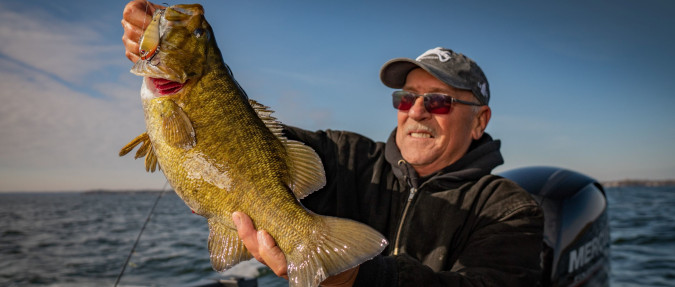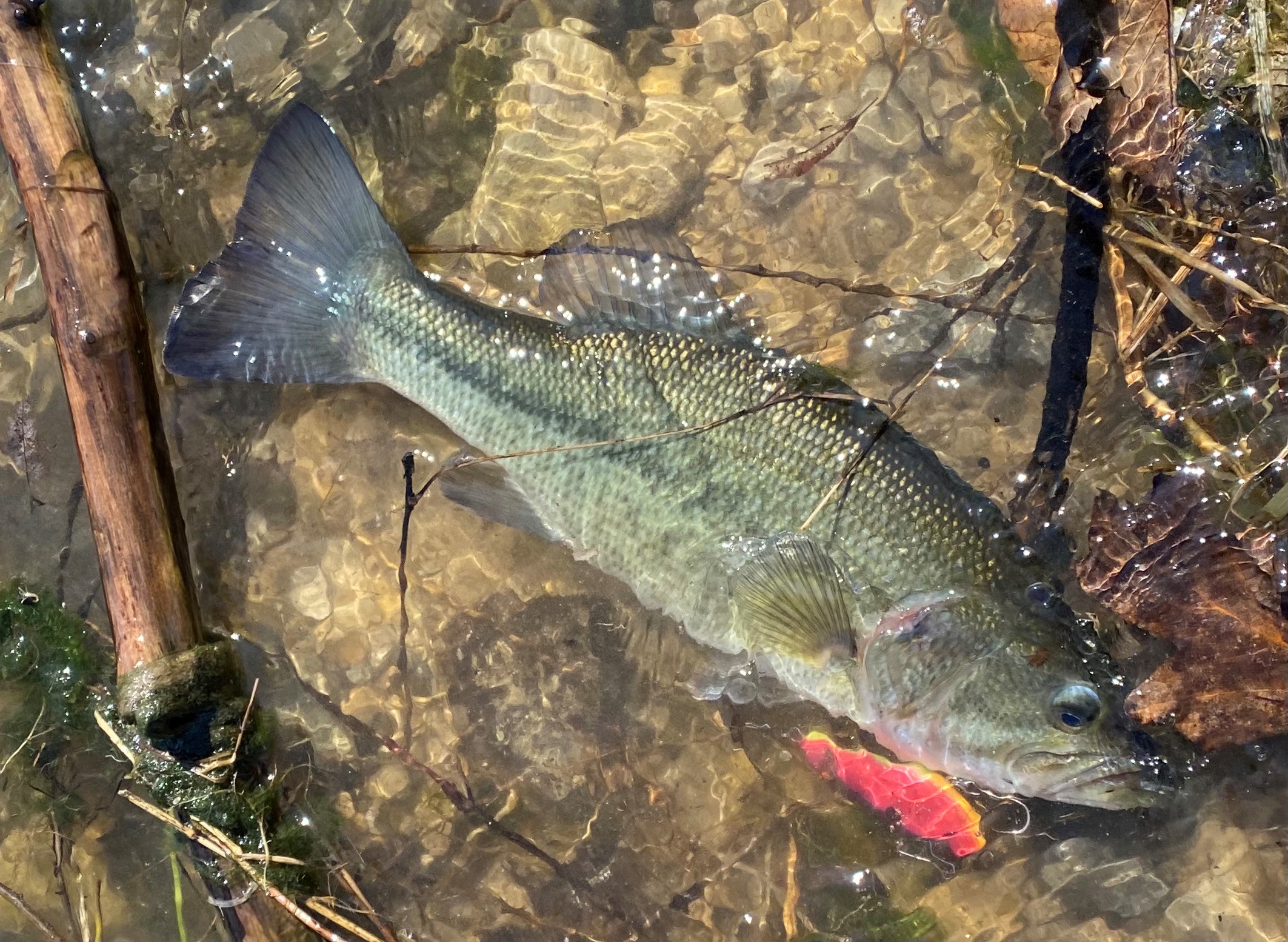 Learn how and where to fish lipless crankbaits to catch more bass this spring.
Learn how and where to fish lipless crankbaits to catch more bass this spring.
Cold water and lipless crankbaits. So wedded are these concepts that many anglers have missed out on the four-season versatility of these simple looking lures.
Of course, there’s no denying the deadly cold-water effectiveness of lipless crankbaits like the BOOYAH Hard Knocker and One Knocker and Cotton Cordell Super Spot. Travel bass waters anywhere when fishermen have donned their winter wear, and you’ll likely find these lures working overtime. Although lipless crankbaits will work their magic in the steamiest days of July, they seem to save their best performances for the chilly water period of from late fall to early spring.
Sometimes called rattle baits for the sounds they emit, lipless crankbaits make it easy for predators to know they are coming, and the fish can’t seem to resist them when they arrive. Do fish find that rattle an irritating alarm? A wake-up call? A hunger inducer? A prelude to a satisfying meal? Who knows? Whatever the case, bass love them.
 Early Season Bass
Early Season Bass
When winter wanes, bass waste minimal time waiting for a spring movement onto the soon-to-warm flats to feed and eventually spawn.
Years ago, I joined Mark Davis, host of television’s Big Water Adventures, in late February to fish several small lakes in Alabama. We stocked up with several sizes and colors of the XCalibur Xr Series, which are today’s BOOYAH Hard Knocker and Booyah One Knocker lipless crankbaits.
On the day I arrived, big bass were hitting spinnerbaits on a feeding flat adjacent to a spawning cove. The bite ended abruptly when a bone-chilling cold front pushed through that evening. Morning greeted us with 25-degree temperatures and blustery winds that sent snowflakes flying with each turn of the reel handle.
We reassessed over a warm meal, and when we returned to the lake, Davis located a ditch leading into the spawning cove, about 10 feet wide and 2 feet deeper than the adjacent flat. We positioned the boat outside the flat and began to cast the length of the ditch. Anticipating the need to keep our baits deep and the retrieve speed very slow, we switched from baitcasting tackle and 20-pound line to spinning gear spooled with 8-pound test.
Crawling our rattle baits through the slot, we made the best of that cold afternoon with more than 20 bass, nearly all between 3 and 5 pounds.
Same Setting, Different Conditions
We returned to the same place a year later and found more favorable conditions. Fishing from separate boats on a slightly larger lake during a warming trend, we again chose lipless crankbaits. This time, however, bass were more active, ganged up on points and drop-offs adjacent to the feeding/spawning flats.
Big fish responded quickly. On the far side of the lake, Davis began hauling in 5- to 8-pound largemouth. Our boat started slower, but our second bass weighed 9 pounds, 6 ounces. Working a break line that ran parallel to the shore, we sieved through some small bass with our 2.5-inch rattle baits. As we reached a broad spawning cove, we positioned ourselves to work a likely staging area: a point at the mouth of the cove.
I switched to my largest size shad-colored lipless crankbait – today most closely represented in the Bling color BOOYAH Hard Knocker, 3/4-ounce model. Letting the bait fall and reeling it slowly across the bottom, we hit a pair of 5-pounders within our first eight casts. The problem with the slow retrieve, however, was that we were snagging dead brush and vegetation three out of four casts.
I switched to a lift-and-drop presentation, often referred to as a “yo-yo” retrieve. With short pulls and drops, I managed to keep my retrieve alive. The decision delivered unexpected reward. The bait reached bass at the bottom of the water column without hanging up on the dead growth, and a 10-pound, 5-ounce largemouth inhaled it. And that giant was no accident. Bass weighing 8,7, 6 pounds followed on the next three casts.
More rewarding than the catch were the lessons learned.
These trophy bass had staged at a predictable location, on the drop-off at the base of a point entering a prime feeding and spawning flat. For the remainder of that afternoon, we worked outside and inside this and similar structure at other coves.
When the point bite weakened in the afternoon, we moved up onto the adjacent flats inside the cove. The depths here called for the smaller bait, the 1/2-ounce, 2.5-ounce version. To cope with the shallow water brush and vegetation, I switched to a faster retrieve, punctuated with a pause. This stop-and-go retrieve netted another 6-pound bass, and the pageant of heavyweight largemouth resumed.

Lessons learned
Lessons from those early-season outings have had repeated applications in seasons since, in many locations and with largemouth and smallmouth bass alike.
Lesson One: Find the staging areas – Think backward from the areas where you’ve enjoyed your best spring success. Focus on well-defined creek arms, flats, coves and bays. Find identifiable structure, such as points, turns and intersections of main river and creek channels, at the entry points to these areas. Note bottom cover, such as vegetation, stumps, standing timber, and other objects at the edges of the flats. The deeper staging areas will hold the most fish initially. Bass will move up into the arms and bays as water warms, but they will retreat to the closest deep water or cover if conditions become less favorable, especially following a cold front.
On my home lake, a 200-acre reservoir in northern Illinois, these holding/transition areas begin to produce a good lipless crankbait bite shortly after ice out. One large flat has a rounded point with sunken brush in 6- to 13-foot depths and a rocky shoreline reaching all the way to the back of the bay. For weeks this area produces not only big largemouth but northern pike and walleye as well.
Lesson Two: Look for baitfish concentrations. Bluegill are the dominant forage on my home lake, and they gather in huge numbers in the shallow north end of the reservoir shortly after ice out. When a cast into the upper reaches of that tapering arm scatters Snickers-sized bluegill, I know that bass are nearby, either actively corralling bluegill on the flat and against the bank or lying in wait in the deeper water of the adjacent depression. Ice-out/early season bass are hungry. Find the food, and you’ve found the bass.
Lesson Three: Rattle high, rattle low! The BOOYAH Hard Knocker and Cordell Super Spot are rattle baits in the conventional sense, with each sporting a high-pitched sound produced by multiple metal balls in the lure’s body cavity. Many believe the sound resembles that of a school of baitfish dispersing. The BOOYAH One Knocker has a single large tungsten ball in the bait’s body. It produces a thumping sound. What conditions cause bass to favor one sound over the other is an unsettled debate, but no bass arsenal is complete without both.
Lesson Four: Size matters. Lipless crankbaits derive their name from the absence of diving lips. Size and weight largely determine where they will work effectively in the water column. The Super Spot was a pioneering entry in this lure category. It has a more buoyant body than other lipless baits. It shines in shallow water and when fish are feeding high in the water column. The 1/4-ounce version of the Booyah Hard One Knocker occupies a similar niche, also offering a smaller profile.
While fishing Lake St. Clair in early April with guide Gerry Gostenik, he and I found smallmouth funneled into a very shallow bay and preparing for an early spawn. We tried to retrieve with rod tips high, but we could not keep 1/2-ounce Hard Knockers from fouling in vegetation. When we switched to 1/4-ounce baits, however, we quickly tied into bronzebacks approaching 5 pounds.
While bigger baits mimic bigger bait fish, consider that the larger Booyah One Knocker and Hard Knocker also reach deeper into the water column where their bass-attracting falling action comes into play. A yo-yo presentation or a switch to an 8-pound fluorocarbon line enhances the effectiveness of the 1/2- and 3/4-ounce lures for mid-depth and deep-water applications.
Lesson Five: The color code. Carry colors that will enable you to match the predominant forage, but add a few that will simply stand out in turbid conditions. If shad thrive in your waters, you will want colors that will show “shad” in clear, stained and murky conditions. The Yellow Perch pattern will serve when bass are feeding on perch or sunfish. Crawfish patterns are another “must.” Include in this group red patterns like Sunset Craw and Rayburn Red, perennial early season killers! For murky water, chrome and other flashy finishes attract attention.
Lesson Six: Vary your retrieve. A mastery of retrieves will help you get the most from these versatile lures. Sometimes speed alone – matching the rate of retrieve to the mood of the fish – is key. A lift-and-drop retrieve, executing the drop with a semi-slack line, may be the very best way to lure cold water bass.
Working your BOOYAH lipless crankbaits or Cordell Super Spot over the tops of early season vegetation is a bass fishing technique with a heralded legacy. Bass commonly crush the bait as it rips free from the grass. A stop-and-go approach can be equally effective. For deep sluggish fish huddled on a relatively clean bottom, a crawling “slow roll” presentation can make all the difference.
Subtle tackle adjustments can make a major difference as well, particularly when water temperatures range from the 30s to low 40s. With long casts and a lift-and-drop retrieve in play, most strikes will come on the “drop.” In those situations, I prefer the sensitivity of my old graphite cranking rod to the glass models. I sometimes carry a medium power, fast-action rod spooled with fluorocarbon for better feel and a quicker hookset response.
Best rods for bass fishing: Check out this guide for the best rods for bass fishing
Get the most out of your lipless crankbaits this season by expanding your arsenal and adding a few new wrinkles to your presentations.
